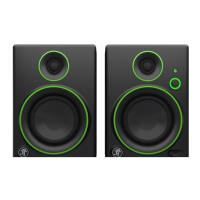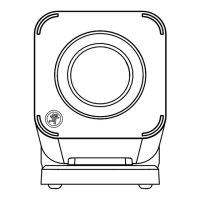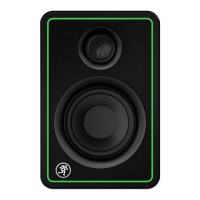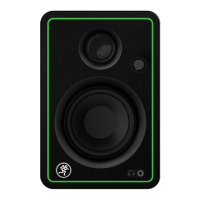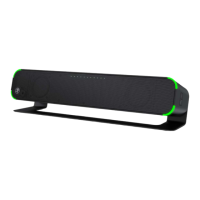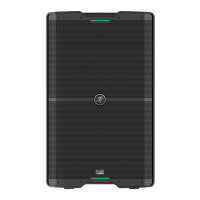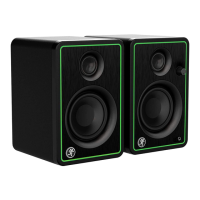Do you have a question about the Mackie C300 and is the answer not in the manual?
Discusses permissible noise levels and the need for hearing protection to prevent hearing loss, referencing OSHA standards.
Essential safety measures for suspending or mounting loudspeakers, including structural integrity and qualified personnel.
Overview of the C300z as a portable two-way loudspeaker system designed to complement Mackie PPM Series mixers.
Details on the 12-inch woofer, 1.75-inch titanium compression driver, and the Low Impedance Compensated Crossover (LICC).
Describes the durable composite cabinet, its design for mounting, stage monitoring, and overall portability.
Initial connection and setup steps for powering on the system safely and correctly, including volume control.
Illustrates how to connect the C300z using a powered mixer and the thru jack for daisy-chaining.
Shows the wiring configuration for using a separate mixer and power amplifier with the C300z.
Details on using the thru jack when connecting with a mixer and power amplifier, allowing signal pass-through.
Illustrates setting up a system using the C300z with a Mackie powered subwoofer for enhanced low-frequency performance.
Recommendations for positioning loudspeakers for optimal performance, including floor, tabletop, monitor use, and avoiding room boundaries.
Explains how room acoustics affect sound and how the C300z's wide dispersion minimizes problems like reflections.
Details the C300z's protection circuit designed to safeguard the high-frequency driver from excessive power and clipping.
Guidance on selecting amplifier power and preventing loudspeaker damage from clipping, with waveform examples.
Information on the M10 rigging points and recommended hardware (eyebolts) for suspending the loudspeakers.
Crucial safety warnings against suspending by handles and the need for professional consultation and correct hardware.
Explains how to obtain warranty service, requirements for claims, and the importance of proof of purchase.
Guides users through common problems like no sound, channel imbalance, and poor bass performance.
Step-by-step instructions for obtaining factory-authorized service, including obtaining a Service Request Number.
Recommendations for cleaning the cabinets and protecting the loudspeakers from moisture and extreme temperatures.
Details on the 1/4" TS and NL4 Speakon connectors, including their wiring and usage for signal input.
Explains nominal impedance and how parallel connections affect it, crucial for amplifier compatibility.
Covers frequency response, SPL, crossover details, input types, power handling, and operating temperature range.
Detailed specifications for the low-frequency woofer and high-frequency compression driver, including dimensions and sensitivity.
Information on the enclosure design, materials, physical dimensions (height, width, depth), and weight.
Lists built-in safety features like driver protection and available hardware options for mounting.
Details the two-year warranty period, what it covers, and eligibility for products sold in the US.
Outlines the process for obtaining warranty service, including requirements, shipping, and proof of purchase.
Explains limitations, exclusions, liability, and the sole warranty provided by LOUD Technologies.
Discusses permissible noise levels and the need for hearing protection to prevent hearing loss, referencing OSHA standards.
Essential safety measures for suspending or mounting loudspeakers, including structural integrity and qualified personnel.
Overview of the C300z as a portable two-way loudspeaker system designed to complement Mackie PPM Series mixers.
Details on the 12-inch woofer, 1.75-inch titanium compression driver, and the Low Impedance Compensated Crossover (LICC).
Describes the durable composite cabinet, its design for mounting, stage monitoring, and overall portability.
Initial connection and setup steps for powering on the system safely and correctly, including volume control.
Illustrates how to connect the C300z using a powered mixer and the thru jack for daisy-chaining.
Shows the wiring configuration for using a separate mixer and power amplifier with the C300z.
Details on using the thru jack when connecting with a mixer and power amplifier, allowing signal pass-through.
Illustrates setting up a system using the C300z with a Mackie powered subwoofer for enhanced low-frequency performance.
Recommendations for positioning loudspeakers for optimal performance, including floor, tabletop, monitor use, and avoiding room boundaries.
Explains how room acoustics affect sound and how the C300z's wide dispersion minimizes problems like reflections.
Details the C300z's protection circuit designed to safeguard the high-frequency driver from excessive power and clipping.
Guidance on selecting amplifier power and preventing loudspeaker damage from clipping, with waveform examples.
Information on the M10 rigging points and recommended hardware (eyebolts) for suspending the loudspeakers.
Crucial safety warnings against suspending by handles and the need for professional consultation and correct hardware.
Explains how to obtain warranty service, requirements for claims, and the importance of proof of purchase.
Guides users through common problems like no sound, channel imbalance, and poor bass performance.
Step-by-step instructions for obtaining factory-authorized service, including obtaining a Service Request Number.
Recommendations for cleaning the cabinets and protecting the loudspeakers from moisture and extreme temperatures.
Details on the 1/4" TS and NL4 Speakon connectors, including their wiring and usage for signal input.
Explains nominal impedance and how parallel connections affect it, crucial for amplifier compatibility.
Covers frequency response, SPL, crossover details, input types, power handling, and operating temperature range.
Detailed specifications for the low-frequency woofer and high-frequency compression driver, including dimensions and sensitivity.
Information on the enclosure design, materials, physical dimensions (height, width, depth), and weight.
Lists built-in safety features like driver protection and available hardware options for mounting.
Details the two-year warranty period, what it covers, and eligibility for products sold in the US.
Outlines the process for obtaining warranty service, including requirements, shipping, and proof of purchase.
Explains limitations, exclusions, liability, and the sole warranty provided by LOUD Technologies.

